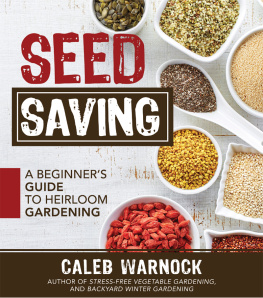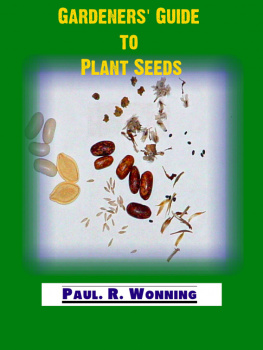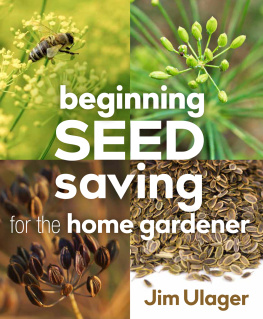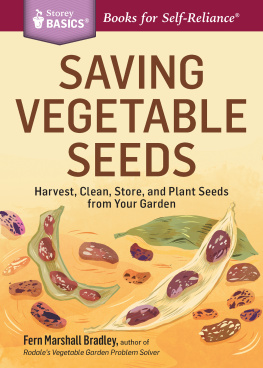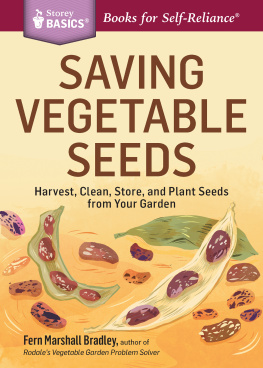the garden seed saving guide
EASY HEIRLOOM SEEDS FOR THE HOME GARDENER
THIRD EDITION
Jill Henderson

Library of Congress Cataloging-in-Publication Data is available upon request.
No part of this book may be reproduced or transmitted in any form or by any means whatsoever including photocopying, scanning, digitizing, recording, or any form of information storage-and-retrieval system, without written permission from the author or her heirs with the exception of brief quotations in articles or reviews.
Disclaimer of liabilities: Reference in the publication to a trademark, proprietary product, or company name is intended for explicit description only and does not imply approval or recommendation to the exclusion of others that may be suitable.
While every effort has been made to ensure the accuracy and effectiveness of the information in this book the author makes no guarantee, express or implied, as to the procedures contained herein. Neither the author nor the publisher will be liable for direct, indirect, incidental, or consequential damages in connection with or arising from the furnishing, performance, or use of this book.
2017 Jill Henderson
All rights reserved. No portion of this book may be reproduced by any means whatsoever, except for brief quotations in reviews, without written permission from the publisher.
Cover and interior design: John Wincek
Stock photography: 123 RF
Printed in the United States

GroundSwell Books a div. of Book Publishing Company
PO Box 99
Summertown, TN 38483
888-260-8458
bookpubco.com
We chose to print this title on responsibly harvested paper stock certified by the Forest Stewardship Council, an independent auditor of responsible forestry practices. For more information, visit https://us.fsc.org.
ISBN: 978-1-57067-346-7
22 21 20 19 18 17 1 2 3 4 5 6 7 8 9
contents






the garden seed saving guide
EASY HEIRLOOM SEEDS FOR THE HOME GARDENER
THIRD EDITION
introduction
Why Save Seed?
Thomas Jefferson said The greatest service which can be rendered any country is to add a useful plant to its culture. If thats true, then the second greatest service would be to save the seeds of those useful plants.
But, besides being of service to ourselves and our country, why should the average person save their own seed? The easiest answer to that is, to save money.
I dont need to tell you how expensive garden seeds are, especially if they are organic. You could pay a small fortune to buy the seeds you need to grow even a modest size garden. With seed packs costing an average of $2.50 each, growing a garden large enough to sustain a family of four could cost hundreds of dollars a year. When you multiply the amount of money spent on seeds and plants by the number of years you plan to garden, the numbers grow even larger. By saving your own seed, you not only reduce the cost of growing your own food for that year, but for many, many years to come.
If you have never saved your own seed I think you might be surprised by how much seed can be reaped from just one type of crop. Have you ever eaten a watermelon? Can you guess how many seeds are inside of just one medium-sized fruit? Thats a lot of seed to tuck away for your arsenal of self-sufficient food production, and all in a single season. Learning to save seed is a wonderful hobby and very rewarding, but its also about survival. The seed you save from three watermelons would be enough to last you, your family and several friends and neighbors at least two years. Now, thats a lot of money saved!
But, while saving money is a perfectly good reason to save seed, there are several others worth mentioning.
By saving our own seed, we can preserve or enhance the characteristics of a particularly useful or interesting plant through the process of selection. Theoretically, seeds from plants that have grown successfully in a particular environment, such as your garden, are stamped with certain genetic markers that allow it to acclimatize to that particular circumstance. In other words, if you grow a squash successfully in your garden, the next generation grown from those seeds should grow as well or better than the parent plant in the same area.
Of course, I cant talk about saving seeds without discussing genetically modified organisms or GMOsor, as I like to call them: Frankenfood. These Frankenfoods have had their natural genetic structure altered by mixing them with the genes of unrelated speciesincluding those belonging to unrelated plants, animals, insects and even human genes. Now, I dont know what your spiritual beliefs are, but for me, I dont think God intended rice and mice to splice. And spirituality aside, there are serious concerns as to how these genetically modified plants act upon the human body when consumed. There are also very real concerns that these genetically modified organisms will pass their Franken-genes on to other, non-Frankenfood crops.
As a frightening example of this right here in the U.S., Monsanto has quite literally sued the land out from under farmers who were found to have even minute amounts of patented Roundup corn growing in their fields among their other corn. Monsanto sued because they said that these farmers were intentionally growing their patented corn without having paid for the right to do so. The farmers protested, saying that Monsantos Round Up corn must be drifting onto unsuspecting farms from passing grain trucks, or from the seed mill where stray kernels were accidentally being mixed in with other corn seeds. But what they didnt realize was that these new Franken-crops were spreading their Franken-genes through the pollination process to non-GMO crops.
In one devastating example in mid-1998, University of Chicago scientists were experimenting with genetically modifying a variety of mustard to be herbicide resistant. And, although no known gene effecting floral characteristics was altered, the workers noticed that the genetically modified flowers looked a little different than those on the unaltered plants. Though the scientists thought this change was unlikely to be significant, they decided to test the modified plants outcrossing rates, or the rate at which pollen successfully pollinates a female flower to produce viable seed in comparison to the non-altered plants.
It turned out that the genetically engineered mustard had over 20 times the outcrossing rate of the standard mustard. In short, the pollen from the genetically engineered mustard was over 20 times more likely to successfully reproduce than its natural counterpart growing right next to it! This disturbing fact spells disaster for non-GMO crops grown in the same region as open pollinated and organic crops, and its outcome has already been felt by farmers all over the Midwest.
According to the Farmers Guide to GMOs


